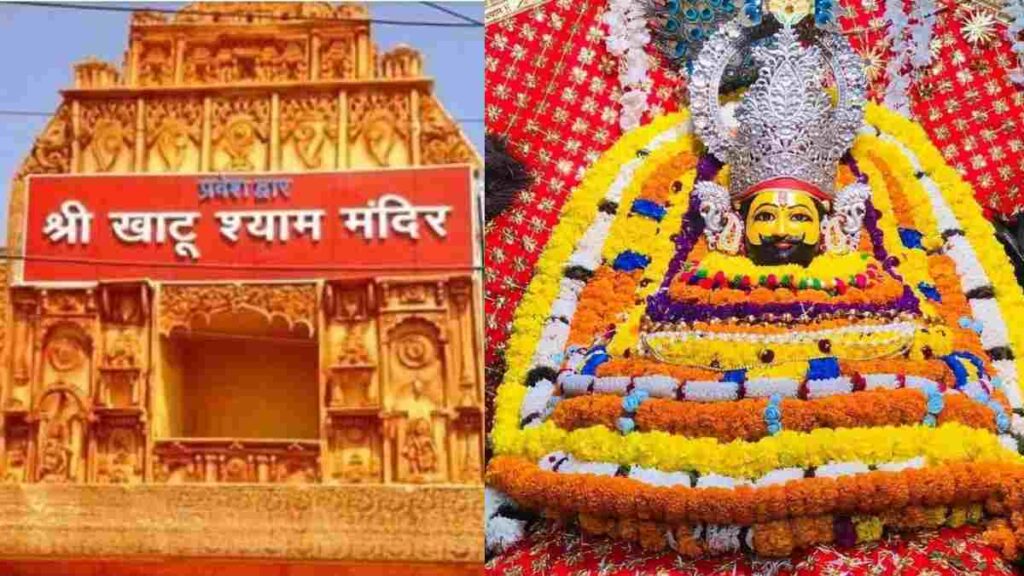
The Khatu Shyam Mandir is thousands of years ancient. This is the most notable temple in Rajasthan, and people from far and broad come here to make a mark. The temple of Shri Khatu Shyam Ji is supposed to be a prominent place of worship for the enthusiasts of Lord Krishna. Khatu Shyam has many names and his glory is also very much.
According to the Hindu religion, Khatu Shyam Ji had received a boon from Shri Krishna in Dwapar Yuga that he would be worshiped by his name Shyam in KaliYuga. Khatu Shyam Mandir Rajasthan is one of the most prominent temples in North India. The offspring of the founders of the temple have historically served the temple. It is acknowledged that about one lakh devotees visit the Shri Khatu Shyam temple every year.
Let’s know more about the history of this temple and what is the glory of Khatu Shyam.
Khatu Shyam Mandir Timing:-
In Summer -
In Winter -

History of Khatu Shyam Temple and its creation:
Shri Khatu Shyam Mandir is known for the idol of Krishna. This is one of the most prominent places of worship in the state of Rajasthan. The popularity of the city has increased due to the existence of this very captivating temple.
The story of Khatu Shyam Mandir comes from the centuries-old Hindu epic of Mahabharata. One of the Pandavas, Veer Barbarika, the great-grandson of Bhima, is deemed a great devotee of Lord Krishna. He sacrificed his head as a symbol of his love for Shri Krishna. Engraved by this great self-denial, the Lord blessed the brave Barbarika. The boon was that he would be worshiped in the form of Shyam in Kali Yuga. Devotees of Lord Krishna believe that the Lord always satisfies the desires of those with a pure soul.
It is believed that the temple was built by Raja Roop Singh Chauhan, the ruler of Khatu Shyam, and his wife Narmada Kanwar. Roop Singh had a dream in which he was asked to build a temple by taking out Shyam Sheesh from a kund in Khatu. The same pool later came to be titled ‘Shyama Kund’.
The mythological story of Khatu Shyam Temple:
There is also a belief that about 1000 years ago, on the day of Ekadashi, Baba’s head was found in Shyamkund. Here there was a big peepal tree near the well. Coming here, the milk of the cows used to flow automatically. The villagers were surprised by giving milk to the cows. When the villagers excavated the place, the head of Baba Shyam was found. Sheesh was handed over to Queen Narmada Kanwar of the Chauhan dynasty, later in Vikram Samvat 1084, this Sheesh was established in the temple. The day was Devuthani Ekadashi. Devotees take a holy bath in this holy pond with the belief that this bath will help them. It Will get rid of all disorders and infections.
The current architecture of the temple has been refurbished by Diwan Abhay Singh around 1720. Lord Barbarik, is supposed to be the divinity of the present time (Kaliyuga). Here he is idolized as Lord Krishna. Lord Khatu Shyam, revered in Hinduism as a helper to the needy, resides here and is well-known for responding to all the prayers of his devotees.
How to reach Khatu Shyam Mandir:
The temple of Khatu Shyam is present in Khatu village, 80 km from Jaipur. The closest railway station to reach Khatu Shyam Ji is Ringas. From where the distance of Baba’s temple is 18.5 km. After exiting the railway station, you can take a taxi and jeep to the temple. If you are moving by flight, then the most immediate airport is Jaipur International Airport. The distance of the temple from here is 95 km. If you are going from Delhi to By Road Shri Khatu Shyam Mandir, then it will take you about 4 to 5 hours to arrive.
Conclusion:
The history of the Shri Khatu Shyam Mandir is associated with the Mahabharata period. The Khatu Shyam temple in Sikar, Rajasthan is the most well-known of the temples of Lord Krishna in India. Khatu Shyam Ji is deemed to be the most famous God of Kali Yuga. He is also called Khatu Naresh. If you are going to Rajasthan then you must visit them. People come on foot from far away with the trail.


